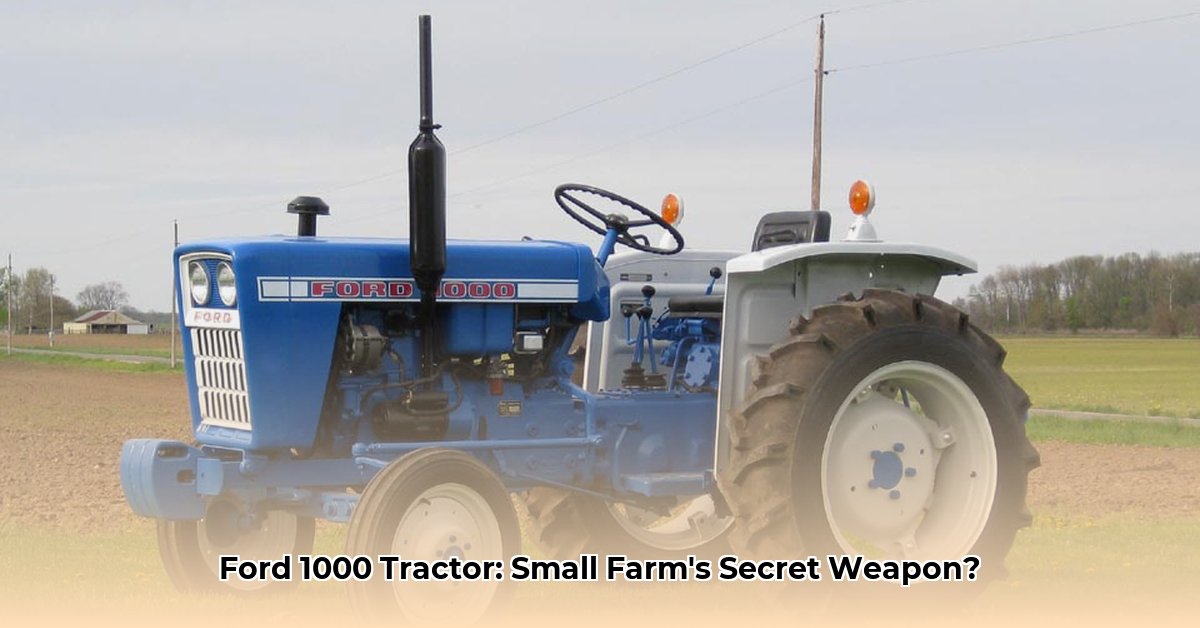
Tractor Ford 1000: A Small Farm Powerhouse?
The Ford 1000 tractor, a compact machine produced by Shibaura for Ford from 1973 to 1978, offers a compelling case study in the evolution of sustainable small-scale farming. Its design and capabilities reflect the agricultural priorities of its era, prompting us to examine how those priorities align with modern sustainability goals. This article delves into the Ford 1000's technical specifications, historical context, and its implications for contemporary farming practices. For more on classic Ford tractors, see Ford tractor specs.
Getting to Know the Ford 1000
Designed for smaller farms, the Ford 1000's 25-horsepower engine and 62.6-inch wheelbase prioritized maneuverability and efficiency in smaller fields. Its nine-speed transmission provided versatility, yet its 5.8-gallon fuel tank hinted at its limitations for extended operations. This compact design, while fuel-efficient for its time, lacked the advanced fuel injection and emission controls of modern tractors, underlining the evolving nature of sustainability standards. Isn't it fascinating to consider how our definition of "sustainable" changes with technological advancement?
Sustainability: Then and Now – A Shifting Landscape
Was the Ford 1000 truly sustainable? Its compact size likely minimized soil compaction, beneficial for soil health. Its efficiency for its intended tasks probably translated to less fuel consumption compared to larger tractors. However, its reliance on fossil fuels and the absence of modern emission controls significantly diminish its sustainability score by current standards. This highlights how practices considered environmentally sound in the past may not meet today’s more stringent criteria. The Ford 1000 serves as a powerful reminder of the continuous evolution of sustainable farming practices.
Modern Alternatives: A Look at Today's Options
Modern compact tractors offer significant improvements in fuel efficiency and emissions. When selecting equipment today, the environmental footprint is paramount. Electric tractors are gaining popularity for smaller farms, offering cleaner alternatives and often incorporating GPS guidance and other smart features to enhance efficiency and reduce labor costs. How will technology's continued evolution shape future definitions of sustainable agriculture?
Specs and Comparisons: A Side-by-Side Look
A comparison of key features reveals significant differences between the Ford 1000 and contemporary compact tractors (note that specifications can vary based on manufacturer and model):
| Feature | Ford 1000 Tractor | Modern Compact Tractor (Example) |
|---|---|---|
| Horsepower | 25 | 35-50+ |
| Fuel Tank (gallons) | 5.8 | 10-20+ |
| Transmission | 9-speed | Varied (Hydrostatic, CVT common) |
| Emission Controls | None | Tier 4 (or equivalent) |
This comparison emphasizes the strides made in engine power, fuel capacity, transmission technology, and emission controls. This evolution is critical in the pursuit of truly sustainable farming techniques.
The Ford 1000's Enduring Legacy
Despite its age, the Ford 1000 holds relevance. For collectors, it represents a significant piece of agricultural history, showcasing the evolution of farming technology. For those studying the history of farming, it offers unique insights into sustainable practices of its time. Ultimately, the Ford 1000 serves as a testament to the ongoing pursuit of more sustainable methods in agriculture.
How to Improve Fuel Efficiency of Older Compact Tractors
Key Takeaways:
- Proper maintenance (air filters, lubrication, tune-ups) is crucial for fuel efficiency optimization in older tractors.
- Efficient operating techniques (avoiding engine lugging, maintaining proper tire inflation, load matching) significantly impact fuel consumption.
- Using high-quality fuel minimizes engine inefficiencies and increases fuel efficiency.
The Ford 1000's enduring legacy extends to the current focus on improving fuel efficiency in older compact tractors. By employing best practices, farmers can maximize performance and minimize the environmental impact of older equipment.
Optimizing the Ford 1000's Performance
The Ford 1000's fuel efficiency can be significantly improved through several strategic interventions.
1. Regular Maintenance: Clean air filters, proper lubrication, and regular tune-ups are essential for optimizing combustion and reducing fuel consumption. How often should these maintenance tasks be performed to achieve maximal fuel efficiency?
2. Operational Techniques: Avoiding engine lugging, maintaining proper tire inflation, and utilizing a tractor properly sized for the task are crucial operational adjustments that directly impact fuel efficiency. What percentage improvement can be expected from these techniques?
3. Fuel Quality: Using high-quality fuel, free of impurities, ensures peak engine performance and contributes to better fuel economy.
Comparing the Ford 1000 to its Contemporaries
While not renowned for exceptional fuel efficiency compared to modern tractors, the Ford 1000 possesses advantages. Its simplicity and ease of maintenance often make it an affordable option. Comparing it to contemporary compact tractors, such as Kubota models often lauded for fuel economy, necessitates a broader analysis of total cost of ownership (TCO). A newer Kubota might offer better fuel economy, but the initial purchase price and long-term maintenance could surpass the Ford 1000’s total operational costs, particularly for owners with mechanical skills.
Beyond Fuel: The Bigger Picture of Sustainable Farming
Sustainable farming encompasses a broader range of practices. Implementing crop rotation, improving soil health, and employing effective pest management are equally important. The selection of a tractor is just one element within a larger framework of environmentally sound agricultural practices, highlighting the Ford 1000's continued relevance in this context. The holistic approach to sustainable farming emphasizes minimizing inputs while maximizing outputs.